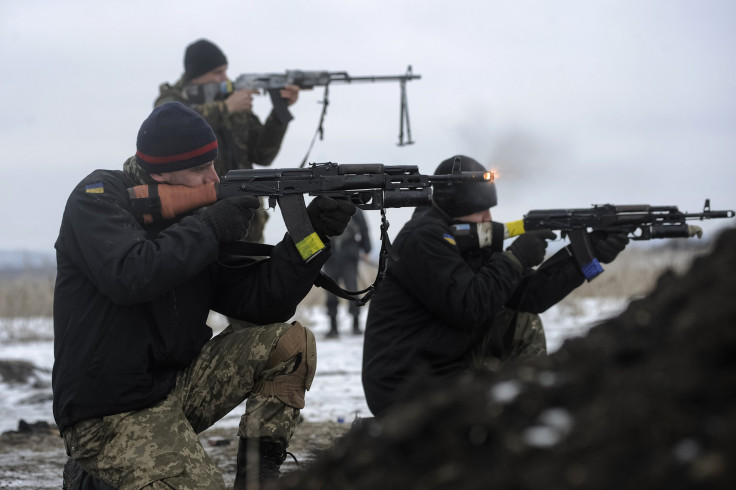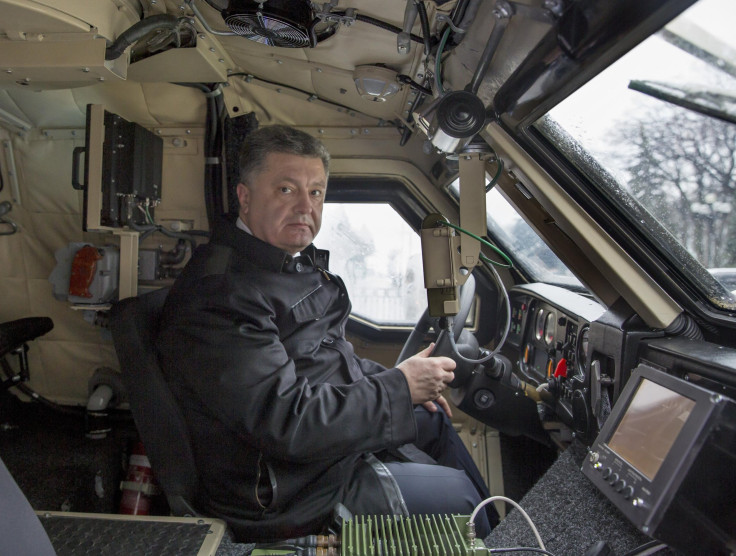Ukraine Is Fighting A 21st Century War With Cold War Arms

Ukrainians' persistent pleas to Western nations and NATO to supply them with weapons and funding to upgrade their arsenal underscore the nation’s struggles to maintain its large post-Soviet military despite its limited economic means and widespread corruption. With its sizable share of Soviet assets, Ukraine had the second-largest armed forces in Europe and the fourth-largest in the world following the 1991 collapse of the USSR, behind only Russia, China and United States. But by the beginning of the separatist conflict in March 2014, Ukraine had just 6,000 troops ready for combat and only a sixth of its aircraft and anti-aircraft systems were a functional state, according to the Moscow Times. Only four of the Ukrainian navy’s vessels were combat-ready prior to the conflict.
Most Ukrainian soldiers are equipped with Soviet-era rifles and operate Soviet-era tanks, which the Ukrainian military complex can repair with its stores of spare parts. Only five of Ukraine’s new Oplot tanks are operational and only 500 of its new Fort-221 rifles are in service, according to Russia Insider. For a look at just how much equipment is rusting away in Ukraine, check out the Telegraph's photo tour of a tank graveyard on the outskirts of Kharkov.
Ukraine lost a staggering 220 tanks, or a quarter of its total, and more than 480 armored vehicles through August of last year through combat, breakdown or capture by the rebels, according to GlobalSecurity.org. See the group's website for a full table of Ukraine’s plummeting military figures from 1990 through 2014.
To rapidly build up its forces in the face of a potential Russian invasion, Kiev has issued four mobilization orders, or draft orders, over the past year. President Petro Poroshenko signed the latest such mobilization in January. The government hopes to muster 50,000 soldiers by April and 200,000 through the end of the year, according to the National Radio Company of Ukraine.

Ukraine currently has around 41,000 regular combat troops plus perhaps 20,000 Ukrainian irregulars who joined volunteer battalions, according to Reuters. Reports from the front line say those volunteer units are equipped poorly, though, and often given the bottom-of-the-barrel weapons from Ukraine’s Cold-War arsenal, even as they serve in the most forward roles on the front line. Morale remains a huge problem.
U.S. President Barack Obama will decide in the coming weeks whether the U.S. will supply Ukraine -- which is not a NATO member -- with the sophisticated weaponry, like anti-tank systems and devices that can pinpoint artillery fire. So far, top U.S. diplomats have indicated they have no plans to go ahead with arming Ukraine. The most prominent supporters of sending arms are a group of eight former high-level diplomats who published a 12-page appeal to Obama and NATO appealing for action. They say Ukraine can’t stand up to the sophisticated weaponry Russia is supplying to rebels.
Ukraine’s problem started when it inherited a massive military built up when it was a key republic of the Soviet Union, second only to Russia in population and economy.
“When the Soviet Union broke apart, all of the former Soviet counties had to create their own military and they all had problems with that,” said Richard Weitz, director and senior fellow at the Center for Political-Military Analysis at the Hudson Institute in Washington. “Russia is the only one that really pulled out ahead. ... The Ukrainians had less success. They had too many people that they weren’t paying, too few modern weapons, and their organization was chaotic as well.”
The Ukrainian military adopted a hybrid of former Soviet tactics and modern Western tactics and systems, which left the military disorganized and susceptible to Russian infiltration, according to Aural Braun, research associate at the Centre for Russian and East European Studies at the University of Toronto.
What operational military capabilities the country did have suffered under massive political and military corruption. Knowing the government couldn’t afford to maintain the massive stores of inherited Soviet equipment, Ukraine sold hundreds of tanks, vehicles and arms to third countries from 1992 on, making it one of the world’s largest military exporters all the way up to 2012, when it sold $1.3 billion worth of equipment. Most of what it didn’t export was put into storage.
Ukraine was making steps to gradually modernize their military just prior to the conflict. It ended conscription in 2013 and had plans to reduce the size of the military by nearly 50 percent from 2012 to 2017 in order to allocate funds to training and new equipment, but the Maidan revolution and separatist movement in the east put that on hold.
Fed up with missed pay and low morale, at least 16,000 former Ukrainian military personnel in Crimea defected to the Russian armed forces when Russia annexed the territory in March. The rest of Ukraine’s 100,000 or so troops and equipment were weren’t ready for combat and wouldn’t be without months of training and in the case of equipment, repair.
Still, early in the conflict Ukraine’s military far outgunned the eastern separatist forces, which at the time were largely armed with outdated weapons bought on the black market, captured police arms and even some self-modified weapons and vehicles. The rebels also had no way of defending against the Ukrainian air force, which helped the Ukrainians make big gains early on. Eventually they captured Ukrainian anti-aircraft systems and allegedly were supplied with sophisticated systems by Russia. Since then 20 helicopters and 13 fixed-wing aircraft have been shot down by separatists.
“You have to measure conflicts always in terms of relative strength,” said Braun. “You can ask, ‘what are the capabilities of Ukrainian military?’ but it won’t always give you a relevant sense of the situation. What if they went to war with Moldova? I’m confident they would be successful, but Russia has put massive funds into upgrading their military, enormously increased their cyberwarfare capabilities and developed sophisticated weapons.”
© Copyright IBTimes 2024. All rights reserved.





















